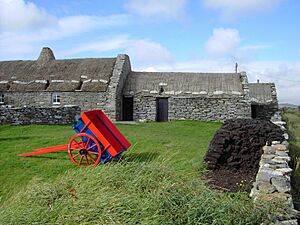The Goodman's Croft facts for kids
The Goodman's Croft was an old superstition (a belief not based on facts) popular in Great Britain, especially Scotland, during the 1500s and 1600s. People also called it by other names, like the Guideman's Grunde or Deevil's Craft.
This practice involved leaving a piece of good farming land unplowed. People dedicated this land to a supernatural being, hoping to make it happy. They believed this would bring them good luck. Many crofters (farmers who worked small plots of land) left these patches untouched. They did this to make sure their farms and animals would do well. If a crofter plowed this special land, people believed it would bring bad luck. This bad luck often showed up as diseases in their cattle.
Why did people oppose the Goodman's Croft?

Most of what we know about the Goodman's Croft comes from religious groups. These groups strongly disagreed with the practice. They saw it as wrong and tried to stop it.
For example, in 1594, the Church of Scotland spoke out against it. They said it was "not labouring ane parcell of ground dedicate to the Devil." This meant they believed people were giving land to the Devil. The Church thought this was a form of Satan worship. However, some people think these offerings were actually much older. They might have been given to general 'spirits' from a time before Christianity.
What did the Church think?
The Church saw the "good man" who owned the croft as a mysterious figure. They believed this figure was a source of magical power. Because of their Christian beliefs, the Church could only see this figure as the Devil. This shows how old gods and spirits from pagan times were later seen as evil.
Church leaders worked hard to end this practice throughout the 1500s and 1600s. They often used large fines to punish anyone who continued to practice it. Even though one person, Jonet Wishert, was linked to the 'Good Man's Croft' for witchcraft in 1596, there are no official records of this specific unplowed field in witchcraft cases.
When did the practice end?
Many of these special unplowed lands stayed untouched for a long time. They were not farmed until the 1800s. At that time, farmers faced tough economic pressure. They needed to use every bit of their land to make enough money.
Crofters had a difficult choice. They could either pay big fines from religious leaders. Or, they could risk their cattle getting sick and dying by farming the 'Good Man's Croft'. This pressure eventually led to the end of the Goodman's Croft tradition.

